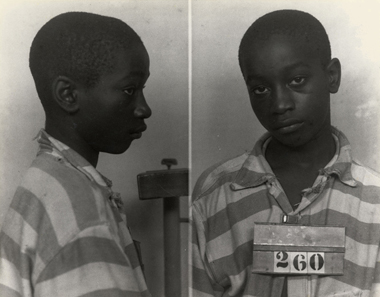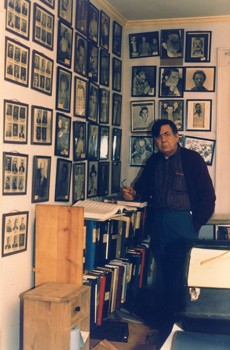UAlbany Launches Project to Digitize History of Executions in the United States
 |
|
The mug shot of 14-year-old George Stinney (part of the M. Watt Espy Collection at UAlbany), the youngest person to be sentenced to death and executed in the United States following a racially-biased trial. For more than 40 years, Espy, an opponent of the death penalty, traced the often tragic history of legal executions in the United States.
|
ALBANY, N.Y. (April 17, 2017) – The M. Watt Espy Papers, execution files on more than 15,000 legal executions in the United States since 1608, are getting a digital makeover.
Hailed by the New York Times as "America's foremost death penalty historian," M. Watt Espy (1933-2009) devoted more than 40 years to cataloging each legal execution since the founding of the Jamestown Colony. In 2008, Espy donated his collection to the University at Albany Libraries’ National Death Penalty Archive.
The work is supported through a grant from the Council on Library and Information Resources (CLIR), which selected UAlbany to receive a 2016 Digitizing Hidden Special Collections and Archives grant. As one of only 17 awards out of a total of 144 applications nationwide, the grant will create the Digital Archive of Executions in the United States, 1608-2002 from the M. Watt Espy Papers’ execution files on over 15,000 legal executions in the United States.
The Digital Archive of Executions will be a searchable database of nearly 150,000 documents freely available online to scholars, researchers, and students with metadata available on individuals executed, their race, gender, crime, and method of execution, along with Espy’s written analysis.
A first of its kind database, the Digital Archive of Executions will appeal to a broad range of scholars, including those interested in history, political science, criminal justice, sociology or law. Future researchers might utilize specific records related to individual criminal cases, while others might review broader material to analyze umbrella issues, like innocents executed, or collect data to mount a legal defense.
All of this information will be freely exposed as linked data though a modern application programming interface (API) to enable a wide variety of computational use. The project will try to incorporate user-centered design, which means we are going to get feedback from users as early as we can. The objective is to produce a system that is intuitive and looks and acts like the rest of the web.
 |
|
M. Watt Espy in his office at the Capital Punishment Research Project, Headland, Alabama.
On the walls are portraits of death row inmates. (Courtesy M. Watt Espy Collection, University at Albany Libraries)
|
Espy devoted nearly four decades of research to documenting more than 15,000 executions in America, dating from 1608 in colonial Jamestown, inspiring the New York Times in a 1987 article to describe Espy as America's foremost “death penalty historian.” Espy traveled extensively, spending countless hours painstakingly compiling information about executions becoming widely known for his unique collection of files on capital punishment. Beginning in 1970, with only his personal resources, Espy began his quest to verify all government sanctioned executions in this country. Espy’s research and writing profoundly shaped scholarship on capital punishment. Prior to his work, most scholars estimated there had been roughly 5,000 people executed in the United States.
Over the course his research, Espy created over 25,000 typed index cards that summarize the story of individual executions, with references to source material. The cards document brutal murders, robberies gone wrong, slave revolts, and judicial processes of states, colonies, Native American tribes, and the federal government. Some of the individuals executed are not documented anywhere else in the historical record, and examining the results of horribly deviant crimes or possible miscarriages of justice when an innocent person was sentenced to death provide a different perspective on society.
Espy also collected over 100,000 pages of primary and secondary source material on executions spanning hundreds of years, which provide an unrivaled window into the nation's death penalty practices. The enhanced availability of these uniquely valuable historical records, made possible through their digitization, represents a tremendous opportunity for researchers and promises to be a watershed event for advancing death-penalty scholarship.
The 17 grants selected by CLIR in comprise the second group of projects supported by the Digitizing Hidden Special Collections and Archives awards program, which is supported by funding from The Andrew W. Mellon Foundation. The Digitizing Hidden Collections program supports the creation of digital representations of unique content of high scholarly significance that will be discoverable and usable as elements of a coherent national collection.
For project updates go to: http://library.albany.edu/archive/espyproject
About the Council on Library Information Resources
CLIR is an independent, nonprofit organization that forges strategies to enhance research, teaching, and learning environments in collaboration with libraries, cultural institutions, and communities of higher learning. In 2008, CLIR started the Cataloging Hidden Special Collections and Archives initiative to help libraries, archives, and cultural institutions describe and catalog millions of items that have never been adequately described and remain inaccessible to scholars.
The program supports innovative, efficient description of large volumes of archival collections that are unknown and inaccessible to scholars, yet contain substantive intellectual value. With the generous support of The Andrew W. Mellon Foundation, since the program began, 87 grants totaling nearly $20 million have been made to a variety of institutions nationwide. For further details about other funded projects go to: http://www.clir.org/hiddencollections/awards/.
About the National Death Penalty Archive
Housed at the Libraries' M.E. Grenander Department of Special Collections & Archives, the National Death Penalty Archive mission is to build a collection of archival materials from individuals and national organizations that played substantive roles in the history of capital punishment. Through a partnership between the School of Criminal Justice and the Libraries that began in 1999, NDPA has acquired personal papers and organizational records to document the emergence, development, and coordination of a political and social movement related to the death penalty. The NDPA collections present a comprehensive picture of political debate, reform, legal maneuvering, and academic research from nationally recognized experts on legal executions in the United States.
Scholars gain access to primary sources that provide insight into the process, influence, and interplay of academic scholarship and political debate over capital punishment. The NDPA contains primary sources in compelling thematic areas, such as civil rights, advocacy efforts of victims' families, and legal history as well as research examining challenges to the death penalty's constitutionality, deterrence, wrongful convictions, and sentences for capital crimes.
![]() For more news, subscribe to UAlbany's RSS headline feeds
For more news, subscribe to UAlbany's RSS headline feeds
A comprehensive public research university, the University at Albany-SUNY offers more than 120 undergraduate majors and minors and 125 master's, doctoral and graduate certificate programs. UAlbany is a leader among all New York State colleges and universities in such diverse fields as atmospheric and environmental sciences, business, education, public health,health sciences, criminal justice, emergency preparedness, engineering and applied sciences, informatics, public administration, social welfare and sociology, taught by an extensive roster of faculty experts. It also offers expanded academic and research opportunities for students through an affiliation with Albany Law School. With a curriculum enhanced by 600 study-abroad opportunities, UAlbany launches great careers.


